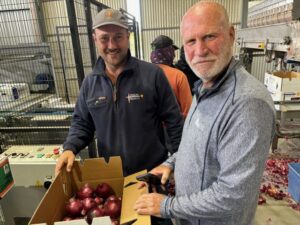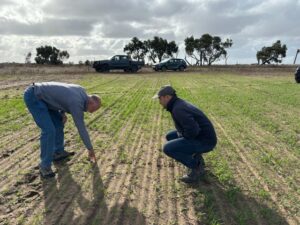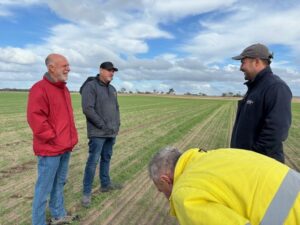Holistic approach to onion management based on observation and research
Pests, diseases and weeds are as much a threat to the US onion industry as they are in Australia. Dr Daniel Drost shared his knowledge and experience of dealing with these threats that has real world applications to Australian onion production systems.
US onion production is in the order of $1 billion a year, across seven main regions around the country. Onion growers typically aim for larger bulb sizes to meet the processed onion market specifications.
While each region may have localised pressures, commonalities such as onion thrip and weed management warranted national collaboration between a number of researchers including Washington State University and Utah State University.
Onion thrip (thrips tabaci) has been identified as a high priority pest in the US, and a vector for iris yellow spot virus. Onion thrip can cause significant impacts to production yield and quality.
Research across a number of farm systems throughout the year, showed that thrip counts per plant were variable and that red onion varieties tended to be more heavily impacted.

“The initial research showed that some farms could have low numbers in the summer in one year, and high numbers the following year,” said Dr Daniel Drost of Utah State University.
“It was important that we learned the thrip lifecycles to better determine how to combat the problem.
“Each adult is highly reproductive, and all adults in the field are female and capable of laying eggs, so the populations can explode very quickly. Given that the chemistry half-life is relatively short, the net effect is very little protection, creating a futile cycle of spray and monitor, spray and monitor.”
The management plan evolved to reduce thrip populations, not eradication using integrated cultural practices.
Dr Drost says that growers are best placed to trial and observe the changes that are made on farm, under their own farming system. A reduction in nitrogen application by a number of innovative growers showed that it reduced thrip populations without adversely affecting the onion yield or quality.
In order to grow and reproduce, onion thrips require protein and nitrogen from the plants. With lower levels of nitrogen applied to the crop, the protein levels are reduced, restricting the number of eggs that can be laid. The flow on effect was that those farmers were able to reduce the number of chemistry spray from the average of seven to eight per season, to just one or two. The level of iris yellow spot virus had also noticeably dropped.
Dr Dan Drost talks with onion growers during his visit to Australia in June 2024
Integrated management for rotations and weeds
“Lowering nitrogen application however, is not a silver bullet solution,” said Dr Drost.
“Crop rotations, host plants and weeds also need to be considered in order to keep the onion thrip numbers down during the winter, so they are manageable in the early stages of onion growth.
“In the US typical crop rotations are lucerne, wheat and corn to provide silage for the dairy industry. However, if lucerne is growing adjacent to onions, there is opportunity for onion thrips to move with each lucerne cut forming a green bridge between crops. The same for wheat when it starts to dry out – thrips will look for another host.”
Dr Drost said that growers need to be cognizant of what commodities are cropped adjacent to onion fields, as well as the rotation for disease management in-field. Dr Drost’s team found large numbers of adults in corn, but not eggs – it is likely that the coarseness of the leaves is the deterrent.
Weeds such as mallows, flixweed and dandelion can also be hosts. Using pre-emergent chemistries prior to the first true leaf, and post-emergent chemistries after the first two true leaves are developed will minimise the ‘weed hotel for thrips’ and lower the risk of iris yellow spot virus.
Dr Drost said it was also important to manage weeds on the crop perimeters, as onion thrips are good fliers and can move to the onion plant once it has emerged.
Holistic ‘farm scape’ for improved onion quality
One of the key messages from Dr Drost was that while many of the issues facing onion growers have commonalities across the world, each farm has its own ‘farm scape’. By understanding the local nuances of climate, weather and other factors local to the farm, the grower can fine tune production inputs such as water in response to local conditions.
Traditionally in the US, onion production was based on furrows whereby water was driven from one side of the field to the other, relying on the ground to be sloped.
With increasing pressure for usage, water security particularly in western USA, is driving many onion growers to be cognizant of how water is used, its wastage and timing to give the desired production outcomes with less. Growers are now switching to drip systems, reducing the amount of water needed for the same production outcomes.
“When you grow an onion crop, the commonalities are the greater than the differences around the world.
“The research that we do, that information can be shared, but the nuances of the farm – the farm scape – are better understood by the farmer. The climate and weather might be different from farm to farm, so our role is to listen to your local issues and see what we can do to find a solution.
“Ultimately a farm is a business, so we need to understand the common issues, but also the local factors that affect onion crop variability.
“It has been a real pleasure to visit Australia and see that onion growers here face much the same challenges in the USA and around the world, but also to learn from each other.”
Meet Dr Daniel Drost
Dr. Dan Drost is Professor Emeritus of Horticulture and former Extension Vegetable Specialist in the Department of Plants, Soils and Climate at Utah State University. Dan grew up on a small diverse farm in western Michigan where he learned the meaning of hard work and how to trouble shoot problems. He received a BS degree in Agricultural Education (1979) and MS in Horticulture (1982) from Michigan State University. After teaching in the Horticulture Department at Massey University, New Zealand for several years (1983-87), he completed his education at Cornell University, receiving his PhD in Vegetable Physiology (1991).
Dan and his family moved to Utah in 1992 after he was appointed the Vegetable Specialist for Utah State University. Since then, he has helped Utah’s vegetable industry remain competitive and sustainable. Dr. Drost’ responsibilities include efforts in extension, research and teaching that addresses plant growth and crop production issues that impact Utah’s commercial vegetable farms. His extension/research interests extend to a variety of crop production issues common to Utah farms. He worked extensively with Utah’s onion industry to combat onion thrips, iris yellow spot virus, and improve their irrigation management. He was part of several national onion research programs that addressed common problems for all onion growers. He has shared these finding with onion producers in England, Germany, New Zealand, and across all important onion growing regions in the United States.
Dan was a key speaker for the Onion event at Hort Connections 2024.
These projects are funded by Hort Innovation using the onion industry research and development levy and contributions from the Australian Government.
Projects: VN20001, VN22000


